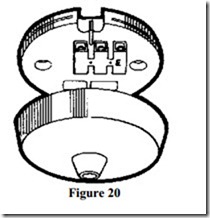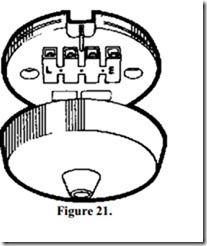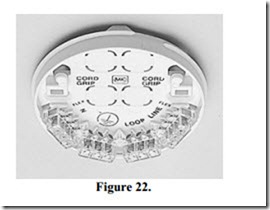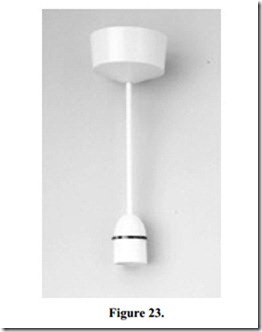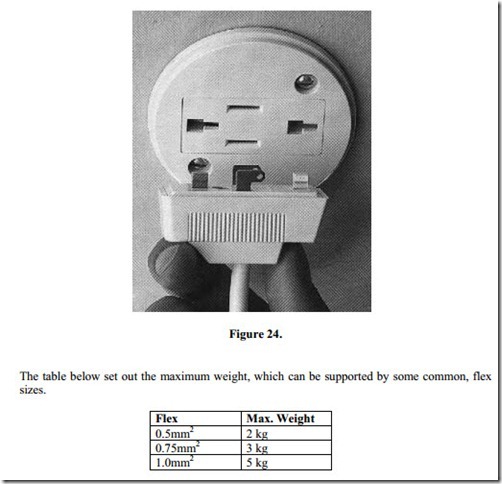Ceiling Roses
There are basically two types of ceiling rose available, although there is a wide range of makes and shapes. The two types are the Two-Plate Ceiling Rose, which has two terminals and the Three-Plate Ceiling Rose, which has three terminals. Both were developed for use on different wiring systems. Older types of ceiling roses were developed at a time when it was not necessary to provide an earth at lighting points. It is now essential to provide an earth, and so an earth terminal is now included on all ceiling roses. This in effect means that a Two-Plate Ceiling Rose has a third terminal fitted, whilst a Three-Plate Ceiling Rose has four terminals.
Figure 20 illustrates one of the original types of Two-Plate Ceiling Rose. The earth terminal is marked “E” and the two unmarked terminals are used for the neutral and the switch wire. There must also be a cord grip provided similar to that in a lampholder.
Figure 21 illustrates a Three-Plate Ceiling Rose. The additional terminal, marked L, is for the Phase or ‘Live’ conductor, which is present in a lighting system wired using the Three-Plate Ceiling Rose Method.
Figure 22 illustrates a modern type Three-Plate Ceiling Rose which has been designed to minimise installation time, and maximise safety of the installer and the end user. Each of the four terminal blocks have three individual terminal screws. It caters for the connection of twelve conductors.
Figure 23 illustrates a lampholder connected to a ceiling rose. The complete unit is called a pendant. The flex connecting the lampholder to the ceiling rose should be a minimum of 0.5mm2. Heat Resisting White Circular PVC type is recommended.
Pendants are available from certain manufacturers in a range of flex length. This allows installations to be completed more efficiently.
Figure 24 illustrates a plug-in type ceiling rose and safety lampholder, which can be easily removed without leaving exposed conductors. The safety lampholder incorporates contacts, which are automatically disconnected from the supply, when the lamp is removed.
Related posts:
Incoming search terms:
- types of ceiling rose
- types of ceiling roses
- three plate ceiling rose
- electronic celiling roz
- main types of ceiling rose
- two types of ceiling rose
- cealing rose connection y
- where electrical ceiling rose are use
- ceiling roses electrical briefly
- function of ceiling rose
- how many type of celling rose the we have
- different types of ceiling roses
- function ceiling rose in electricals
- ceiling rose electrical definition
- ceiling rose types
- FUCTION OF CEILING ROSES IN ELECTRICAL
- what are types of ceiling rose
- electrical ceiling rose
- function of a ceiling rose
- how did cillingrose holda fiting
- how many types of ceiling rose do we have
- how many types of ceiling roses
- Two types of ceiling roses in electrical instalation
- two types of ceiling roses
- Two plate ceiling rose
- three plate ceiling rose meaning in hindi
- three plate cealing rose
- Name two types of ceiling rose?
- mention three types of ceiling roses in electrical
- Illustrate Plate Ceiling Rose
- ceiling roses electrical domestic
- electrician IS symbols two plate ceiling rose
- ceiling roses 3 plate type is used
- ceiling Rose/electrical
- ceiling rose used for
- ceiling rose electric
- ceiling rose online
- Ceiling rose in electrical
- ceiling rose electrical theory
- Ceiling rose
- ceiling roses and its function in electrical
- ceiling roses electrical
- electric chiling roje
- Different types of electrical ceiling rose
- celling roz types
- celling roses and ttypes
- Celling rose
- Celeing roses
- ceilling roses and type
- ceilling rose mean
